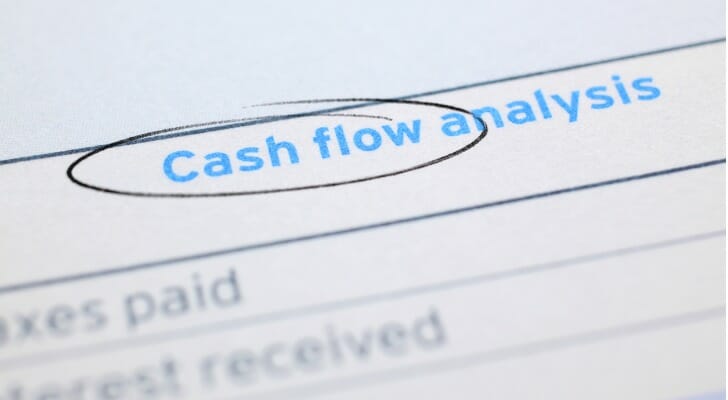 Discounted cash flow, or DCF, is a tool for analyzing financial investments based on their likely future cash flow. When an investment will cost more money to buy, generate less money in return, or require greater tradeoffs, its DCF will rise. In these cases, you may be better off doing something else with that money. On the other hand, if an investment costs less, generates better returns, or has fewer tradeoffs, it may be a good use of your funds. DCF helps you to break that analysis down into a specific dollar amount at which a given investment becomes worthwhile. Here’s how it works.
Discounted cash flow, or DCF, is a tool for analyzing financial investments based on their likely future cash flow. When an investment will cost more money to buy, generate less money in return, or require greater tradeoffs, its DCF will rise. In these cases, you may be better off doing something else with that money. On the other hand, if an investment costs less, generates better returns, or has fewer tradeoffs, it may be a good use of your funds. DCF helps you to break that analysis down into a specific dollar amount at which a given investment becomes worthwhile. Here’s how it works.
What Is Discounted Cash Flow?
A discounted cash flow analysis helps investors to decide whether an investment with a rate of return, such as a business or a debt instrument, is worth the money it will cost up front. This is based on two related concepts: cost of capital and the time value of money. This is not an analysis built for capital gains returns, which do not provide regular cash flows but rather generate money in one lump sum upon the sale of the asset.
The cost of capital is how much it costs you to raise a given amount of cash. For example, say you want to expand your business and approach the bank for a loan. If the bank offers to extend this loan at a 3% interest rate, that 3% is your cost of capital.
The time value of money also measures the opportunity costs of money over time. For example, say you have an investment which returns a 5% interest rate per year. If you put $100 into that investment today, in one year it would grow to $105. Getting $100 today, then, is worth more than getting $100 a year from now because of the opportunity for investment.
Time value of money is the idea that, while the specific return may change, it is generally always true that money in the future is worth less than money today.
A discounted cash flow analysis combines these two ideas. It looks at an investment and asks: Given the likely return on this investment (the time value of money) and the discount rate of the investment’s initial costs (the cost of capital), is this investment worth its costs?
The Discounted Cash Flow Formula
The discounted cash flow formula is:
- DCF = (C1 / (1+R)^1) + (C2 / (1+R)^2) + … (Cn / (1+R)^n)
Now, let’s look at this in detail.
- DCF – This is our result, the discounted cash flow of an investment or project.
This is expressed as a total value, not a percentage or a decimal. When we calculate the discounted cash flow, our final result will be the amount of money that this investment is worth. Pay more than the DCF and you will lose money on this investment relative to its returns and the cost of capital. Pay less than the DCF and you will make money.
- Cn – The cash flow for each given year of the investment.
This formula uses the anticipated cash flow for every year of an investment over the relevant period. For example, C1 is the cash flow that you would expect this investment to generate in its first year, C2 is the cash flow you would expect in its second year and so on until we reach Cn, where “n” is the last year of the analysis. Most discounted cash flow analyses will measure the value of an investment five years into the future.
This is the weakest part of this analysis.
While a discounted cash flow has the reliable appearance of a mathematical formula, the truth is that it is largely a speculative project. Your results are only as certain as the data you put in, and there is no clear way to know how much any investment will return in the years ahead. Cash flow is an educated guess at best, and the results of a discounted cash flow analysis should be treated accordingly.
- R – This is the cost of capital, otherwise known as the discount rate.
The discount rate can be calculated in many ways. When a business conducts this analysis, it will often use what is called the “weighted average cost of capital.” This is a way of measuring how much it costs the company to raise money on a per-dollar basis.
Other investors will use simple lending interest rates for the discount rate (for example, if it costs 4% to borrow the money used to make an investment, that is the discount rate). Still others will use the rate of return on a guaranteed investment for the discount rate. For example, say that Treasury bonds have an interest rate of 2.5%. This means that an investor could always get at least a 2.5% rate of return for their money. They will compare other investments against that sure thing and treat anything less as an effective loss.
Terminal Value
Some discount cash flow analyses use what is called a terminal value.
With a terminal value, you will calculate out the DCF formula for each year in your analysis (for example, years one through five). You will then calculate one additional year’s worth of cash flow based on an estimate of the investment’s long-term potential growth. Terminal value attempts to capture the value of an investment outside the boundaries of any given formula’s specific analysis.
Given the indefinite time frame that this attempts to estimate, terminal value is a speculative metric and, while not uncommon, is also not standard.
Example of Discounted Cash Flow
 Let’s say that you are thinking of buying the business ABC Corp. To do this, you would need to borrow money from the bank at an interest rate of 4%. That cost of borrowing will be your discount rate; it is the cost of money over time.
Let’s say that you are thinking of buying the business ABC Corp. To do this, you would need to borrow money from the bank at an interest rate of 4%. That cost of borrowing will be your discount rate; it is the cost of money over time.
Looking at ABC Corp., you see that the firm has projected its income for the next five years:
- Year 1 – $250,000
- Year 2 – $300,000
- Year 3 – $220,000
- Year 4 – $350,000
- Year 5 – $410,000
Using this information you can now decide exactly what this investment is worth:
- DCF = (C1 / (1+R)^1) + … (C5 / (1+R)^5)
This is our base formula. Note that the divisor for the first year is to the first power, for the second year to the second power and so on. Thus, ^3 in the formula below means (1 + 0.04) to the third power or 1.12. We will measure out to five years, as is standard for a DCF analysis.
- DCF = (250,000 / (1 + 0.04)^1) + ($300,000 / (1 + 0.04)^2) + ($220,000 / (1 + 0.04)^3) + (350,000 / (1 + 0.04)^4) + (410,000 / (1 + 0.04)^5)
This is the formula filled in with our hypothetical values. Each year includes that year’s projected cash flow along with the discount rate. Note that each year’s discount rate increases to reflect the fact that this money will grow more valuable as time goes on.
- DCF = 250,000/1.04 + 300,000/1.08 + 220,000/1.12 + 350,000/1.17 + 410,000/1.22
This is the formula with each year’s discount rate calculated out.
- DCF = 240,384 + 277,777 + 196,428 + 299,145 + 336,065
This is the formula with each year’s discounted cash flow calculated out.
- DCF = $1,349,799
This is our final discounted cash flow for the total investment. This investment is worth a little bit less than $1.35 million.
When we weigh the costs of borrowing against the likely returns that you will get from investing in ABC Corp., we get a discounted cash flow of $1,349,799. This is the amount of money at which your investment will make enough back that it will have been worth the costs. If you can buy ABC Corp. for less than this, it will be a profitable investment. More than this and it will likely be an unprofitable investment.
The Bottom Line
 Discounted cash flow is a way of analyzing whether an investment is worth the cost using the time value of money. By weighing the investment’s returns over time against the cost of investing, you can find the price at which an investment is worthwhile – or the price at which it is potentially a bad idea. The weakness of DCF is that estimating future cash flow needed to use this technique is speculative.
Discounted cash flow is a way of analyzing whether an investment is worth the cost using the time value of money. By weighing the investment’s returns over time against the cost of investing, you can find the price at which an investment is worthwhile – or the price at which it is potentially a bad idea. The weakness of DCF is that estimating future cash flow needed to use this technique is speculative.
Tips for Investing
- Consider talking to a financial advisor about various analytical tools to help you invest. Finding the right financial advisor who fits your needs doesn’t have to be hard. SmartAsset’s free tool can match you with up to three local financial advisors, and you can choose the one who is best for you. If you’re ready to get connected to an advisor near you, get started now.
- One of the easiest ways to get started investing is with an investment calculator. Just enter the starting amount, annual contributions, estimated rate of return and length of investment. From there you can move on to an asset allocation calculator to get a sense of the mix of investments in your portfolio that fit your financial goals.
Photo credit: ©iStock.com/Guillaume, ©iStock.com/anyaberkut, ©iStock.com/blackred